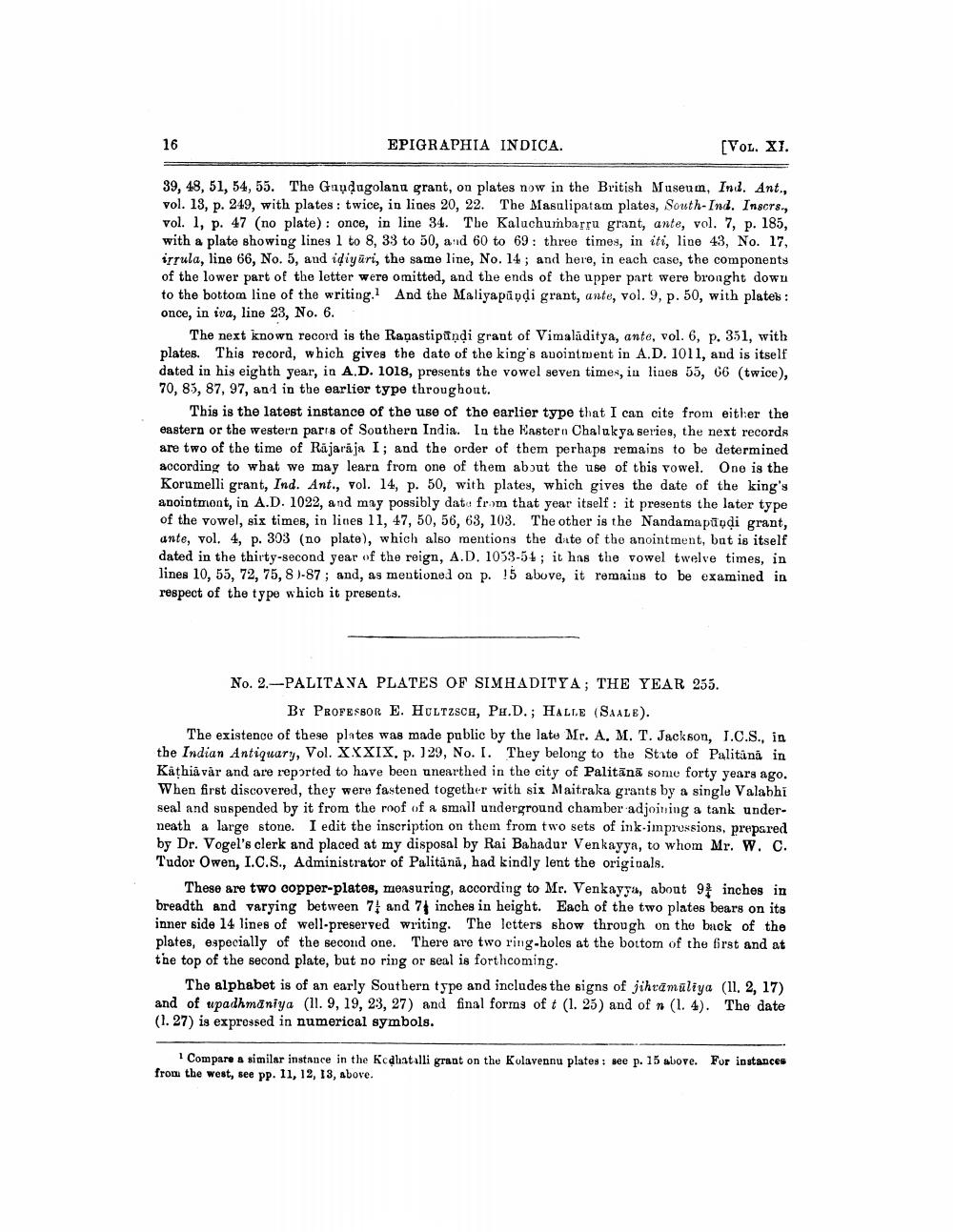________________
EPIGRAPHIA INDICA.
[Vol. X1.
39, 48, 51, 54, 55. The Guydugolanu grant, on plates now in the British Museum, Ind. Ant., vol. 13, p. 249, with plates: twice, in lines 20, 22. The Masulipatam plates, South-Ind. Inscrs., vol. 1, p. 47 (no plate): once, in line 34. The Kalachumbarru grant, ante, vol. 7, p. 185, with a plate showing lines 1 to 8, 33 to 50, a d 60 to 69: three times, in iti, line 43, No. 17, irrula, line 66, No. 5, and idiyūri, the same line, No. 14 ; and here, in each case, the components of the lower part of the letter were omitted, and the ends of the upper part were brought down to the bottom line of the writing. And the Maliyapandi grant, ante, vol. 9, p. 50, with plateb: once, in iva, line 23, No. 6.
The next known record is the Raņastipữndi grant of Vimalāditya, ante, vol. 6, p. 351, with plates. This record, which gives the date of the king's avointment in A.D. 1011, and is itself dated in his eighth year, in A.D. 1018, presents the vowel seven times, in lines 55, 66 (twice), 70, 85, 87, 97, and in the earlier type throughout.
This is the latest instance of the use of the earlier type that I can cite from either the eastern or the western parts of Southern India. In the Eastern Chalukya series, the next records are two of the time of Rajaraja I; and the order of them perhaps remains to be determined according to what we may learn from one of them about the use of this vowel. One is the Korumelli grant, Ind. Ant., vol. 14, p. 50, with plates, which gives the date of the king's anointment, in A.D. 1022, and may possibly date from that year itself: it presents the later type of the vowel, six times, in lines 11, 47, 50, 56, 63, 103. The other is the Nandama pūodi grant, ante, vol. 4, p. 393 (no plate), which also mentions the date of the anointment, but is itself dated in the thirty-second year of the reign, A.D. 1053-51; it has the vowel twelve times, in lines 10, 55, 72, 75, 81-87; and, as mentioned on p. !5 above, it remains to be examined in respect of the type which it presents.
No. 2.-PALITANA PLATES OF SIMHADITYA; THE YEAR 255.
BY PROFESBOR E. HOLTZSCH, PH.D.; HALLE (SAALE). The existence of these plates was made public by the late Mr. A. M. T. Jackson, L.C.S., in the Indian Antiquary, Vol. XXXIX, p. 29, No. I. They belong to the State of Palitani in Kathiả vár and are reported to have been unearthed in the city of Palitānā some forty years ago. When first discovered, they were fastened together with six Maitraka grants by a singlu Valabhi seal and suspended by it from the roof of a small underground chamber adjoining a tank underneath a large stone. I edit the inscription on them from two sets of ink impressions, prepared by Dr. Vogel's clerk and placed at my disposal by Rai Bahadur Venkayya, to whom Mr. W. C. Tudor Owen, I.C.S., Administrator of Palitană, had kindly lent the originals.
These are two copper-plates, measuring, according to Mr. Venkaya, about 94 inches in breadth and varying between 7 and 7 inches in height. Each of the two plates bears on its inner side 14 lines of well-preserved writing. The letters show through on the back of the plates, especially of the second one. There are two ring-holes at the bottom of the first and at the top of the second plate, but no ring or seal is forthcoming.
The alphabet is of an early Southern type and includes the signs of jihtāmuliya (11, 2, 17) and of upadhmaniya (11. 9, 19, 23, 27) and final forms of t (1. 25) and of n (1.4). The date (1.27) is expressed in numerical symbols.
Compare a similar instance in the Kcdhatilli grant on the Kolavennu plates: see p. 15 above. For instances from the west, see pp. 11, 12, 13, above.




